This short film weaves cultural narratives with western science to remind us what the many large earthquakes on the Alpine Fault over the past millions of years have given us – the foundations for the beautiful landscapes of Te Waipounamu (South Island), and also build understanding of what the next large earthquake could take away and challenge us with – so that we can all take action to be better prepared.
Co-produced by Te Rūnanga o Ngāi Tahu & AF8 with co-sponsorship from Toka Tū Ake EQC.
This StoryMap shares a credible science-based hazard scenario for a major Alpine Fault earthquake. Scenarios bring together all our available knowledge to paint a picture of what we might experience so we can be better prepared for it.
*StoryMap is best viewed on a desktop, laptop or tablet, it is not suitable for viewing on mobile phones or small screens.
The Alpine Fault and our Active Faults is an NCEA Level 1 Geography resource aligned to the new New Zealand curriculum and is designed to teach ākonga all about the Alpine Fault and our active faults, while also learning geospatial information system skills in ArcGIS Online.
Movement along the Alpine Fault, with its powerful uplift along the Southern Alps over millions of years, forms the geological foundations for Te Waipounamu our beautiful South Island and the stunning landscape we call home. The more we understand our natural environment and the forces that shape it, the better prepared we can be.
Our Shaky Isles

The safety of Aotearoa New Zealand’s hydro scheme dams in the face of a large Alpine Fault earthquake is a recurring concern raised at many AF8 Roadshow events. We talked to a chief engineer at Meridian Energy about dam safety.

Magnificent mountains with precipitous snowy peaks may be what Te Tai Poutini, the West Coast of Te Waipounamu, the South Island of Aotearoa, is most famous for. But the flatter land at the foot of the mountains is what’s most valuable to residents, farmers, and travellers of the West Coast. A paper by Kiwi earth scientists highlights the landscape changes expected for this precious, habitable land after large earthquakes.

We are seeking expressions of interest for the newly vacant Science Lead position. The AF8 Programme is seeking a suitably qualified scientist with active Alpine Fault hazard and risk-related research, and strong networks and connections across the science and emergency management sectors.